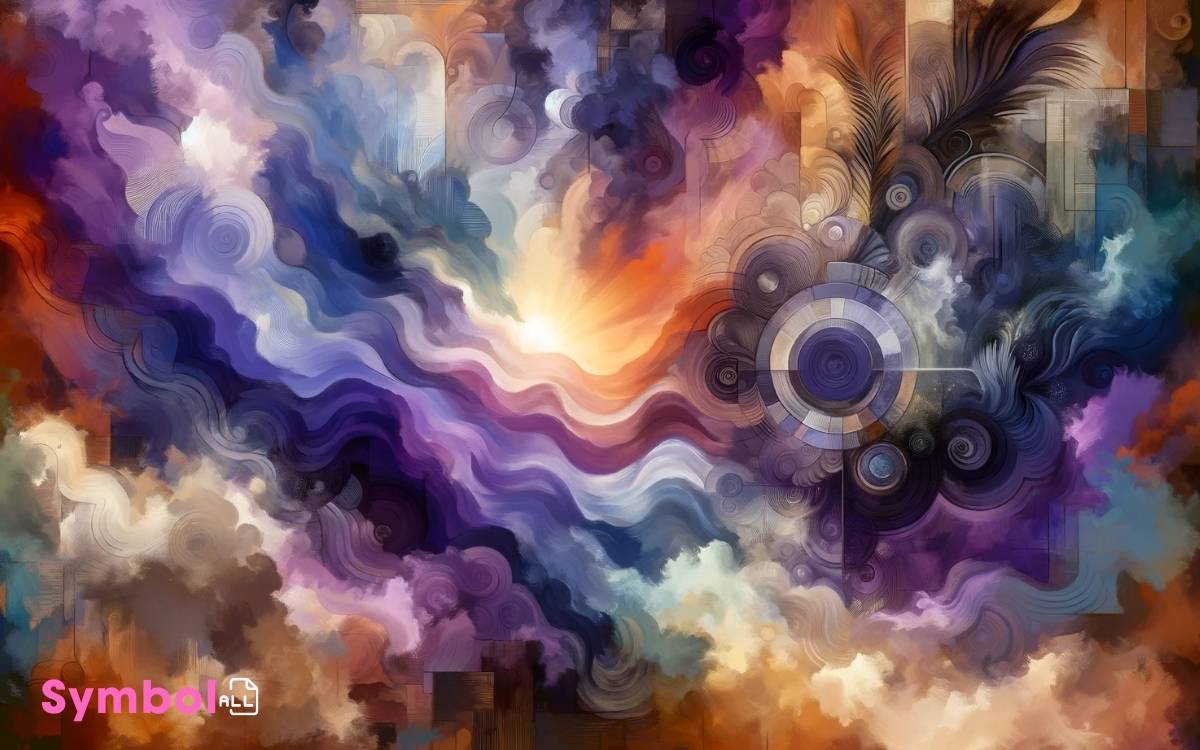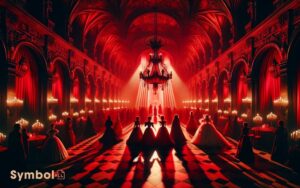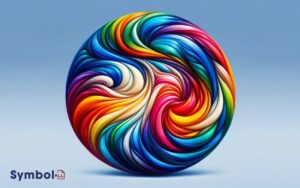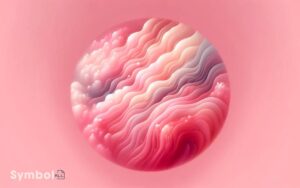What Did the Color Purple Symbolize in Flemish Painting?
In Flemish painting, you’ll find purple isn’t just a color; it’s a symbol steeped in opulence and spirituality. Its rarity and cost meant only the wealthiest, often nobility, could afford it, linking purple indelibly to statuses of power and prestige.
Artists imbued their work with purple to signal not only their technical skill but also the affluence of their patrons. This hue distinguishes sacred figures, enhancing the spiritual narrative of artworks.
For you, understanding purple’s dual role in reflecting both earthly wealth and divine connection offers a deeper appreciation of its historical weight and artistic significance. This perspective opens up new layers to explore in Flemish art’s rich tapestry.

Key Takeaways
The Rarity of Purple
Within the domain of Flemish painting, the color purple’s scarcity underscores its significance, embodying both opulence and mystique. You’ll observe that purple, a hue tied to both ecclesiastical power and secular authority, appears sparingly.
This rarity isn’t a mere coincidence but a reflection of the immense effort and expense required to produce the color. Historically, the source of purple dye was the murex snail, a creature not readily available in the regions where Flemish artists thrived.
Consequently, the color’s presence in artwork signals not just the painter’s technical prowess but also the patron’s wealth and status.
Analyzing the selective use of purple, you’re witnessing a deliberate artistic choice that communicates layers of meaning, from spiritual significance to social hierarchy.
Purple and Nobility
Building on the theme of rarity, the color purple also holds a deep connection with nobility, symbolizing status and power across centuries of Flemish art.
This association isn’t arbitrary; it’s deeply rooted in the cost and difficulty of producing purple dye, which historically came from the rare Tyrian purple snail. Consequently, only the wealthiest, often royalty, could afford garments of this color.
Flemish painters, aware of purple’s prestigious connotations, strategically used it to denote nobility within their compositions.
By incorporating purple, they not only reflected societal hierarchies but also imbued their works with a sense of luxury and exclusivity.
When you encounter purple in Flemish paintings, you’re witnessing a visual cue that communicates wealth, power, and an elite status, meticulously woven into the canvas by the artist.
Religious Significance
Beyond its association with nobility, the color purple also carries profound religious significance in Flemish painting, symbolizing spirituality and piety.
You’ll find that artists meticulously employed purple to denote figures of high spiritual importance, often reserving it for the depiction of holy robes. This choice wasn’t arbitrary but steeped in a rich tradition, where purple represented a connection to the divine.
Analyzing paintings from this era, you’ll notice how purple sets apart the sacred from the mundane, guiding the viewer’s attention towards the spiritual narrative. Its use in scenes depicting biblical tales or saints underlines its role in evoking a sense of reverence and awe.
This deliberate application showcases the artist’s intention to elevate the subject’s spiritual status, making purple a conduit for expressing the ineffable.
Wealth and Opulence
In Flemish painting, the color purple not only signifies spiritual depth but also epitomizes wealth and opulence, marking it as a visual hallmark of affluence and high status.
This association isn’t arbitrary; it’s deeply rooted in the historical context and the material realities of the period.
- Exclusivity of Purple Dyes: Purple pigments were exceedingly rare and expensive, sourced from distant lands or derived from labor-intensive processes.
- Regal Associations: Monarchs and the nobility often wore purple, reinforcing its connection to power and prestige.
- Visual Impact: Purple’s striking presence in art commanded attention, signaling the patron’s wealth and the artist’s mastery.
Your understanding of these factors enriches your appreciation of Flemish artworks, revealing layers of meaning in the choices artists made.
Purple in Everyday Life
You’ll find that purple’s rarity and intrinsic value permeate not only the domains of art but also the fabric of everyday life, imbuing objects and attire with a layer of significance beyond their surface.
This hue’s daily symbolism, often overlooked, carries a rich tapestry of meanings, from spirituality to mourning, that shapes societal perceptions and behaviors.
Through an analytical lens, one must consider how this color’s historical prestige influences its contemporary symbolic roles, offering insights into its enduring allure and complex connotations.
Purples Rarity and Value
Historically, the scarcity of purple dye greatly elevated its value, making it a symbol of wealth and power in various cultures. The extraction process, reliant on the murex snail, was labor-intensive and costly, limiting its accessibility.
This exclusivity imbued purple with a mystique, often reserved for the elite or for ceremonial purposes within a cultural context.
- Extraction Difficulty: The dye’s production required tens of thousands of snails for just one gram, making it exceedingly rare.
- Economic Value: Its high cost made it a luxury item, often more valuable than gold.
- Cultural Significance: Purple’s association with royalty and divinity reinforced its prestige, influencing its use in art and clothing to denote status and power.
Analyzing purple’s historical context reveals its intricate relationship with societal hierarchies and cultural values.
Daily Symbolism of Purple
While the scarcity and worth of purple once restricted its presence to the kingdoms of royalty and divinity, its symbolism has seeped into everyday life, reflecting a wide range of meanings beyond wealth and power.
In the contemporary context, you’ll find purple embodying creativity and imagination, often used to inspire innovation and artistic expression.
It’s no coincidence that brands aiming to convey luxury and quality frequently incorporate purple into their logos and products.
Additionally, this color’s association with wisdom and dignity makes it a preferred choice in academic and spiritual spheres. However, the interpretation of purple isn’t static; it evolves with cultural shifts and trends.
As society progresses, purple’s symbolism in daily life continues to expand, encapsulating nuances of individuality, inclusivity, and the pursuit of personal fulfillment.
Symbolism in Clothing
You’ll observe that in Flemish painting, the color purple doesn’t merely serve an aesthetic purpose in clothing but carries deep symbolic weight.
Its association with royalty is unmistakable, indicating not only social status but also the divine right to rule.
Moreover, its religious significance is profound, often representing penitence and piety, which underscores the moral and spiritual dimensions of the portrayed subjects.
Purples Royal Connotations
Throughout the ages, the color purple has symbolized regal authority and wealth in Flemish painting, a demonstration of its scarcity and the expense involved in its creation. This symbolism wasn’t accidental but deeply rooted in the socio-economic context of the time.
- Exclusivity of Materials: Purple dye, historically derived from the rare Murex snail, was prohibitively expensive, making it accessible only to the wealthiest or most powerful individuals.
- Legislative Restrictions: Laws often restricted the wearing of purple to the nobility, reinforcing its association with status and power.
- Visual Impact: In art, purple garments immediately draw the viewer’s eye, signifying the subject’s high status or divine favor, separate from the common populace.
In this way, purple served as a visual shorthand for authority, wealth, and distinction in Flemish painting.
Religious Significance Explored
Beyond its regal connotations, the color purple also holds profound religious significance in Flemish painting, particularly evident in the symbolism imbued in clothing.
| Garment | Wearer | Symbolic Meaning |
|---|---|---|
| Robe | Virgin Mary | Divine love, suffering |
| Mantle | Christ | Royalty, Passion |
| Tunic | Bishops | Authority, piety |
| Cloak | Apostles | Faith, devotion |
| Scarf | Saints | Martyrdom, sanctity |
This table encapsulates how purple’s use in various garments within Flemish paintings isn’t merely an aesthetic choice but a deliberate, symbolic decision.
Each piece of clothing, from the Virgin Mary’s robe to the apostles’ cloaks, isn’t just attire but a narrative tool, conveying themes of divinity, sacrifice, and spiritual leadership.
Purple, therefore, serves as a visual shorthand for these complex theological concepts, enhancing your understanding of the depicted figures’ roles and virtues.
Purple and Spirituality
In Flemish painting, the color purple often symbolizes spirituality, reflecting a deep connection between the divine and the mundane.
This nuanced symbolism can be unpacked through three distinct lenses:
- Historical Context: Purple’s rarity and cost historically linked it to nobility and clergy, both mediators between the spiritual and earthly spheres.
- Biblical References: The color’s presence in religious texts imbues it with layers of spiritual significance, connecting it to penitence, mourning, and the advent of spiritual awakening.
- Psychological Impact: Purple’s ability to evoke a sense of mysticism and introspection aligns with its role in depicting spiritual themes, guiding the viewer’s perception towards a contemplative state, conducive to spiritual connection.
These aspects collectively underscore purple’s pivotal role in expressing spiritual narratives in Flemish art, offering viewers a conduit to transcendence through visual means.
The Divine Connection
You’ll find that Flemish artists intricately linked the color purple with notions of spirituality, royalty, and divinity in their paintings.
This chromatic choice not only elevates subjects to a celestial domain but also meticulously intertwines them with the divine right of kings, suggesting an almost sacred lineage.
Through this lens, purple transcends mere aesthetic, becoming a pivotal tool for depicting the divine connection in visual narratives.
Spiritual Significance
One can’t overlook the profound spiritual significance of the color purple in Flemish paintings, where it often symbolizes a divine connection between the earthly and the celestial worlds.
This connection is manifested in several ways:
- Symbol of Meditation and Reflection: Purple’s use in backgrounds or garments suggests a contemplative state, guiding viewers towards spiritual introspection.
- Bridge Between Mortal and Divine: By adorning holy figures or the skies surrounding them, purple visually narrates the interplay between human and divine spheres.
- Indicator of Mystical Presence: In scenes depicting miracles or celestial visions, purple hues hint at the unseen, mystical forces at work.
This intricate symbolism underscores the color’s role in conveying messages of faith, transcendence, and the ineffable mysteries that lie beyond human comprehension.
Royalty and Divinity
Historically, purple has served as a visual emblem of both royalty and divinity, embodying the profound connection these domains share with the divine.
This color’s use in Flemish painting was not accidental but deliberate, reflecting a deep understanding of its symbolic power.
To grasp the depth of purple’s significance, consider the following table:
| Aspect | Significance |
|---|---|
| Royalty | Authority, Nobility, Power |
| Divinity | Sacredness, Mysticism, Purity |
| Intersection | Divine Right of Kings, Sanctity |
| Visual Cues | Halos, Robes, Crowns |
This table illustrates the multifaceted symbolism of purple, merging the earthly with the heavenly.
Flemish artists, through their careful application of purple, invited viewers to contemplate the divine endorsement of royal authority, as well as the spiritual purity and mysticism associated with both domains.
Contrasting Meanings
When analyzing the color purple’s role within Flemish painting, it’s crucial to acknowledge its dualistic symbolism, which ranges from symbolizing royalty and spirituality to indicating mourning and penitence.
This variety of meanings adds layers of depth to the artworks, challenging you to ponder:
- Royalty and Spirituality: Purple’s connection with nobility and the divine, reflecting its historical scarcity and high cost.
- Mourning and Penitence: Its use in portraying sorrow and regret, representing a more serious, introspective aspect.
- Social and Economic Status: The inclusion of purple indicating the subject’s affluence or societal position, due to the costly nature of purple dye.
This contrasting symbolism highlights the intricacy of human emotions and societal structures, encouraging a more nuanced interpretation of Flemish art.
Purple in Landscape Art
While exploring the use of purple in Flemish landscape art, it’s evident that artists skillfully employed this hue to convey not only aesthetic beauty but also symbolic depth.
Purple, often associated with nobility and spirituality, was subtly integrated into landscapes to evoke a sense of majesty and transcendence.
This choice of color wasn’t merely for visual pleasure but served as a narrative tool, enriching the scene with layers of meaning that resonate with viewers on a profound level.
| Aspect | Significance | Examples |
|---|---|---|
| Sky and Twilight | Shift, Mystery | Evening landscapes |
| Shadows and Depths | Subtlety, Richness of nature | Forest scenes |
| Garments and Details | Status, Spiritual significance | Figures in landscapes |
| Flowers and Foliage | Fertility, Wealth, Divine connection | Gardens and wild landscapes |
In this context, purple’s duality earthly richness and heavenly aspirations mirrors the Flemish pursuit of capturing the divine within the mundane.
Techniques and Materials
Exploring the techniques and materials Flemish painters employed to achieve the rich, vibrant hues of purple reveals a meticulous blend of science and artistry.
You’ll find that their approach wasn’t just about mixing pigments; it was an intricate process that involved:
- Selection of Pigments: They relied on rare and costly materials, such as lapis lazuli and madder, to produce deep and enduring purple tones.
- Layering Techniques: Applying thin, translucent layers of paint allowed for a complexity in color and texture that mimicked the natural play of light and shadow, enhancing the luminosity of purple.
- Binding Mediums: The choice of oils and resins as binders not only preserved the vibrancy of purple over time but also facilitated the blending of pigments, creating seamless shifts within the color spectrum.
Evolution of Interpretation
Understanding the technical prowess behind the creation of purple in Flemish painting sets the stage to examine how its interpretations and symbolic meanings have evolved over time.
Initially, purple’s rarity and cost made it a symbol of power, wealth, and spirituality, deeply intertwined with the social and religious fabric of the time.
As centuries passed, these interpretations transformed, reflecting changes in society, culture, and even the availability of materials.
| Era | Symbolism | Contextual Shifts |
|---|---|---|
| 15th Century | Royalty, Wealth | Limited to Elite |
| 16th Century | Spiritual Purity | Reformation influences |
| 17th Century | Mourning, Melancholy | Expanding Symbolic Meanings |
| 18th Century | Decadence, Excess | Critique of Aristocracy |
| 19th Century | Creativity, Mystery | Romanticism and Beyond |
This evolution highlights the fluidity of symbolic meanings, shaped by time, societal values, and artistic intent.
Purples Artistic Legacy
The artistic legacy of purple, a color once reserved for the elite, has profoundly influenced the trajectory of Flemish painting, embedding itself in the fabric of art history through its varied and evolving symbolism.
- Symbol of Power and Wealth: Historically, purple denoted status and affluence, a tradition that Flemish artists meticulously incorporated to signify nobility and divine favor in their subjects.
- Spiritual and Mystical Connotations: Beyond material wealth, purple also came to represent spiritual depth, mystery, and penitence, enriching the narrative layers of religious artworks.
- Innovation in Color Technique: The quest to replicate the richness of purple pushed Flemish painters towards innovative techniques, including the development of new pigments and blending methods, significantly impacting the evolution of color theory in European art.
Conclusion
In delving into the depths of Flemish painting, you’ve uncovered the layers of purple’s symbolism: a marker of rarity, nobility, divine connection, and sheer opulence. Yet, beyond these grand themes lies an enigma.
As you trace purple’s journey through landscapes and everyday scenes, its essence remains elusive, morphing with time and technique. The true power of purple, veiled in artistic mastery, challenges us to question—what deeper mysteries does it hold?
Its legacy, rich and complex, continues to captivate and inspire, leaving us pondering its full spectrum of meaning.






